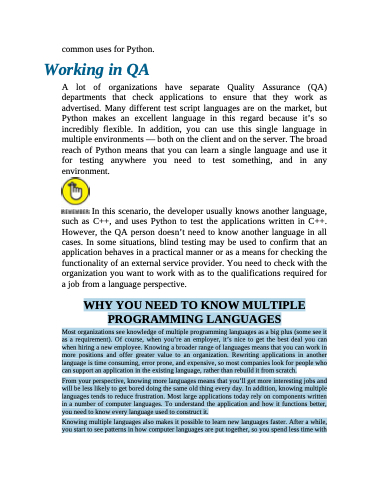Page 421 - Beginning Programming with Pyth - John Paul Mueller
P. 421
common uses for Python.
Working in QA
A lot of organizations have separate Quality Assurance (QA) departments that check applications to ensure that they work as advertised. Many different test script languages are on the market, but Python makes an excellent language in this regard because it’s so incredibly flexible. In addition, you can use this single language in multiple environments — both on the client and on the server. The broad reach of Python means that you can learn a single language and use it for testing anywhere you need to test something, and in any environment.
In this scenario, the developer usually knows another language, such as C++, and uses Python to test the applications written in C++. However, the QA person doesn’t need to know another language in all cases. In some situations, blind testing may be used to confirm that an application behaves in a practical manner or as a means for checking the functionality of an external service provider. You need to check with the organization you want to work with as to the qualifications required for a job from a language perspective.
WHY YOU NEED TO KNOW MULTIPLE
PROGRAMMING LANGUAGES
Most organizations see knowledge of multiple programming languages as a big plus (some see it
as a requirement). Of course, when you’re an employer, it’s nice to get the best deal you can
when hiring a new employee. Knowing a broader range of languages means that you can work in
more positions and offer greater value to an organization. Rewriting applications in another
language is time consuming, error prone, and expensive, so most companies look for people who
can support an application in the existing language, rather than rebuild it from scratch.
From your perspective, knowing more languages means that you’ll get more interesting jobs and
will be less likely to get bored doing the same old thing every day. In addition, knowing multiple
languages tends to reduce frustration. Most large applications today rely on components written
in a number of computer languages. To understand the application and how it functions better,
you need to know every language used to construct it.
Knowing multiple languages also makes it possible to learn new languages faster. After a while,
you start to see patterns in how computer languages are put together, so you spend less time with


